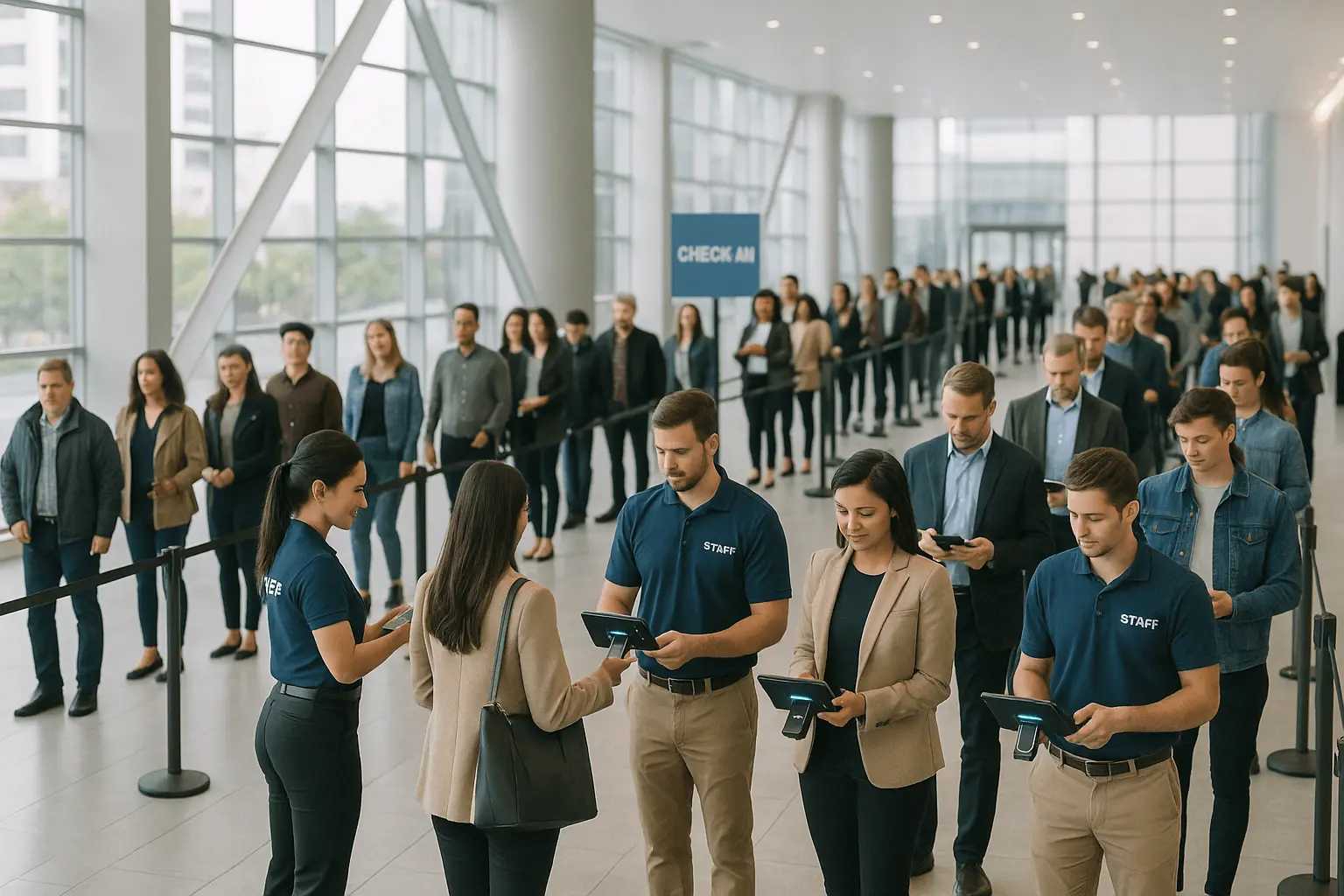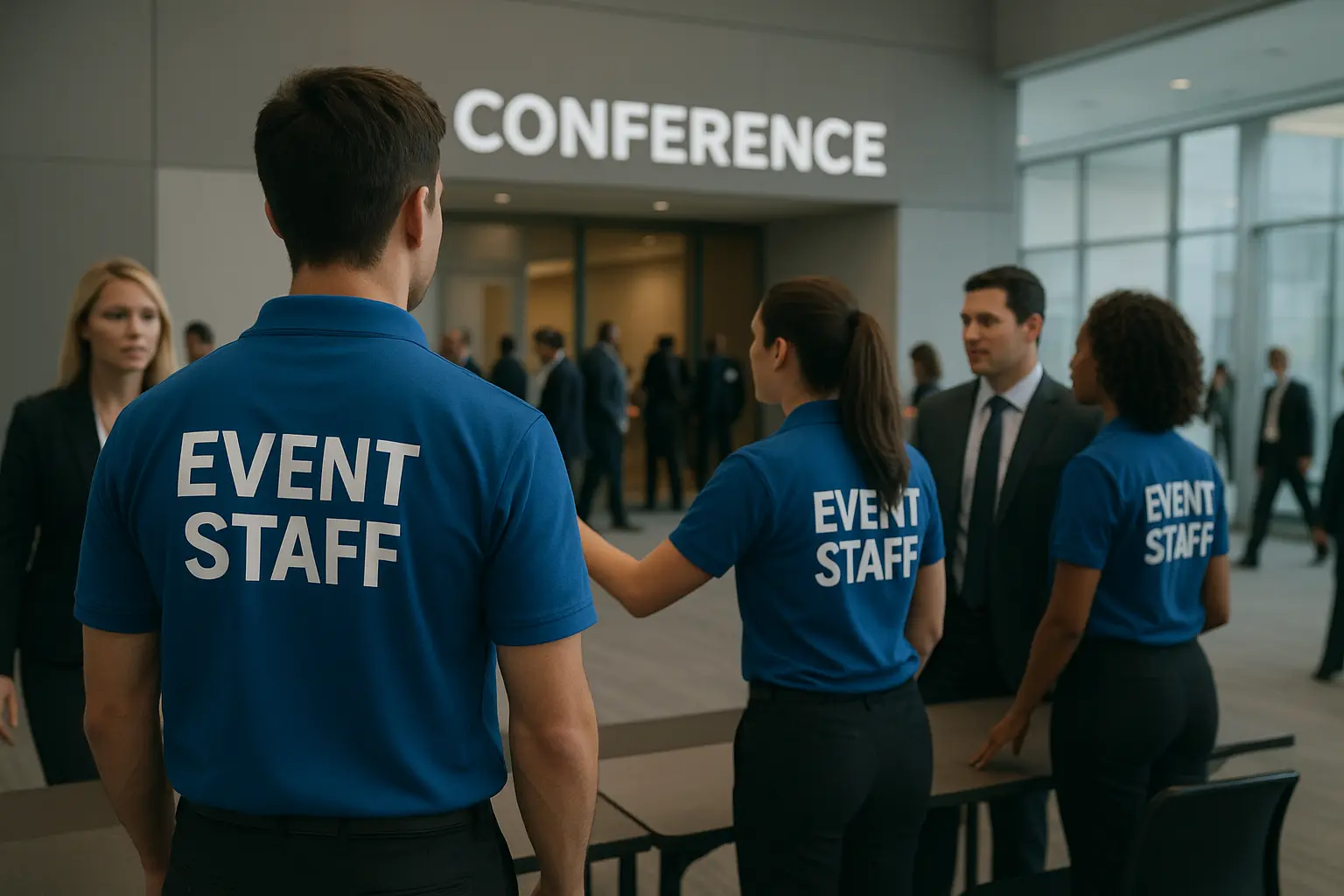A Word From Our CEO
A guest's first impression is made in the queue. We built the Flow Planner because a data-driven event check-in process is the foundation of operational excellence. It's how we turn a failure point into a seamless welcome. – CEO, Event Staff
When your event check-in lines stall, it triggers a chain reaction. Sponsors wait, bars idle, and your event's first impression crumbles before it even begins.
Most check-in failures are a system failure. A poorly planned event check-in process can lead to significant hidden costs, from lost revenue to lasting brand damage. The problem is often not too few staff but the wrong distribution and a failure to accurately model guest arrival patterns.
This guide introduces the Check-In Flow Planner, a pre-event simulation model that turns guesswork into data-driven confidence. It’s designed to help you build and perfect your event check-in process from the very start.
The Core Principles of an Efficient Event Check-In Process
Before using the tool, it's crucial to understand the core operational principles that define a successful event check-in process. These are the foundational concepts that our planner is built upon.
.webp)
Throughput vs. Perception
There is a difference between the actual speed of a line (throughput) and how fast it feels to a guest (perception). A constantly moving line feels significantly faster than a stationary one, even if the total wait time is the same. This is a key principle in managing wait times and a core goal of an efficient entry workflow process.
Arrival Curve Psychology
Guests don't arrive in a steady, even stream; they cluster in waves, with a massive surge typically occurring in the first hour after doors open. A successful event check-in process must be designed and staffed to handle these peaks, not just the average flow over the entire duration.
Staff Distribution
An imbalance of just 10% in staff allocation between gates can easily double queue times at the busiest entry point. This is a core part of effective workforce planning for events and is critical to maintaining a smooth and consistent guest experience across all entrances.
Tech Lag
Every layer of technology or security adds seconds to the check-in time per guest. Factoring in the time for RFID scans, comprehensive bag checks, or metal detectors can increase your total event check-in process time-per-guest by 30-50%, a variable that must be accounted for in your planning.
Latest Trends Shaping the Modern Event Check-In Process
The event check-in process has evolved beyond simple ticket scanning to become a sophisticated technological and experiential touchpoint shaped by these key trends.
- Biometric & Frictionless Entry: The shift toward facial recognition and palm scanning is changing the role of gate staff. They are evolving from manual ticket scanners into tech support specialists who troubleshoot syncing issues and assist guests with navigating these new, faster systems.
- Integrated Health & Safety Screening: While no longer mandatory at most events, the infrastructure for optional, rapid health pass verification is now a common layer in the event check-in process. This requires staff who are specifically trained in handling potentially sensitive information with both speed and discretion.
Introducing the Check-In Flow Planner
This interactive tool is a digital whiteboard for your event check-in process. It's a pre-event simulation model designed to turn guesswork into data-driven confidence. It allows you to model your event's ingress, predict bottlenecks before they happen, and visualize guest arrival surges in real time.
How It Works (3 Simple Steps):
- Enter Your Data: Input your core event variables, including your total guest count, the number of entry gates you plan to use, and your staff per gate.
- Add Your Variables: Adjust the simulation with operational modifiers like your chosen check-in technology, security layers, and expected guest arrival patterns.
- Get Your Projections: Instantly see your projected queue times, total processing capacity, and optimal staff recommendations to fix weak points in your entry workflow process.
The Interactive Check-In Flow Planner
Use this step-by-step planner to generate a custom estimate for your event. While this is a text-based walkthrough, it's designed to function just like an embedded tool, giving you a powerful and realistic projection.
Step 1: Core Event Inputs
- Total Guests Expected: ________ (e.g., 5,000)
- Number of Gates: ________ (e.g., 4)
- Staff per Gate: ________ (e.g., 3)
- Gate Open Duration (minutes): ________ (e.g., 120)
Step 2: Operational Modifiers
- Arrival Pattern: ( ) Steady / (X) Early Surge / ( ) Late Surge
- Tech Used: ( ) QR / (X) RFID / ( ) Manual
- Security Layer: ( ) Standard / (X) Bag Check / ( ) Metal Detector
Step 3: Your Live Projections & Results
(Based on the example inputs, your live projections would appear here)
- Total Processing Capacity: 3,600 guests/hour
- Projected Time to Clear Peak Lines: 25 Minutes
- Queue Peak Size Estimate: 400 guests
- Recommended Additional Staff: 2 (for the first 30 minutes)
This tool provides the data to build a resilient event check-in process.
How the Planner Informs Key Decisions
Here’s how the tool helps you make smart, data-driven decisions for your event guest flow process.
%20(1).webp)
Scenario A (Festival): You're planning a 10,000-guest festival with RFID scanners and expect an "Early Surge." The planner projects a peak queue time of 45 minutes, which is too long. By simply increasing the "Staff per Gate" by one for the first hour, the tool instantly shows the peak queue time drops to a manageable 15 minutes, justifying the minor cost increase.
Scenario B (Corporate Conference): For a 4,000-attendee conference using manual check-in, the tool predicts a major bottleneck at registration. By toggling the "Tech Used" option from "Manual" to "QR," you instantly see that the total processing capacity doubles. This provides a clear ROI justification for investing in QR code technology to create a better event check-in process.
How Staff Turn a Good Plan into a Great Experience
The best event check-in process plan still depends on a well-executed human element. The planner provides the data, but your on-site team delivers the experience.
- Clear Briefings: Your staff must understand the expected guest flow, their specific roles at each station (scanner, troubleshooter, greeter), and who to call for technical or security issues.
- Strategic Signage: Good signage is a silent staff member. It prevents guest confusion, reduces questions, and directs attendees to the correct lines (General Admission, VIP, etc.).
- Proactive Queue Communication: Staff who actively and cheerfully communicate with guests in line ("Just a few more minutes!", "Please have your tickets ready!") dramatically improve the perceived wait time and guest satisfaction. These human elements are how professional hospitality staff elevate the guest experience.
End Note
A chaotic check-in is a costly system failure that can negatively impact an entire event. A proactive, data-driven event check-in process is the only way to guarantee a smooth start. The best events run like clockwork long before the doors open; use the Check-In Flow Planner to stress-test your entry plan, and you can get an instant quote to see how our expert teams turn that plan into a flawless reality.



.webp)

